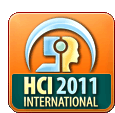T03: Overview of Human Information Processing for Human-Computer Interaction
Half Day Tutorial
Kim-Phuong L. Vu (short bio)
California State University Long Beach, USA
Robert W. Proctor (short bio)
Purdue University, USA
Objectives:
One objective of this tutorial is to provide an overview of fundamental concepts and findings concerning human information processing. Another is to relate contemporary knowledge of human information processing to issues of relevance to HCI.
Content and Benefits:
HCI is fundamentally an information-processing task. The human information-processing approach is based on the idea that human performance, from displayed information to a response, is a function of several distinct processes. The nature of these processes, how they are arranged, and the factors that influence how quickly and accurately a particular process operates, can be discovered through appropriate research methods. Because information-processing analyses are used in HCI in several ways, it is beneficial to be familiar with basics of the approach and specific applications to HCI.
Basic facts and theories about information-processing capabilities are taken into consideration when designing interfaces and tasks. The first part of this tutorial will review classic and recent findings on such topics as attention, memory, decision-making, and action selection, and discuss their relevance for HCI.
Information-processing methods are used in HCI to conduct empirical studies evaluating the cognitive requirements of various tasks in which a human uses a computer. The second part of the tutorial will describe recent developments in empirical methods for studying human information processing, and provide examples of how they can be applied to HCI.
Target Audience:
This tutorial is geared toward human factors and HCI professionals who do not have much background in human information processing or for those who want a refresher course concerning basic principles of human information processing, recent developments in the area, and what it has to offer HCI. It should be of interest to computer scientists, industrial designers, and engineers who want to improve their designs by incorporating information-processing analyses.
Bio Sketch of Presenters:

Kim Vu is Associate Professor of Psychology at California State University, Long Beach. She is Associate Director of the Center for Usability in Design and Accessibility and of the Center for Human Factors in Advanced Aeronautics Technologies. Dr. Vu has over 75 publications in areas relating to human performance, human factors, and human-computer interaction. She is co-author of the chapter, "Human Information Processing: An Overview for Human-Computer Interaction," in The Human-Computer Interaction Handbook (all editions), co-editor of the Handbook of Human Factors in Web Design, and co-author of the book Stimulus-Response Compatibility Principles: Data, Theory, and Application.

Robert Proctor is Distinguished Professor of Psychological Sciences at Purdue University. Dr. Proctor is co-coordinator of the interdisciplinary Human Factors program. He teaches courses in Human Factors in Engineering, Human Information Processing, Attention, and Perception and Action. Dr. Proctor's research focuses on basic and applied aspects of human performance. He has published over 200 articles on human performance and is author of numerous books and book chapters. His books include Human Factors in Simple and Complex Systems, Skill Acquisition and Human Performance, Stimulus-Response Compatibility: An Integrated Perspective, Attention: Theory and Practice, and Human Factors in Web Design. He is Fellow of the American Psychological Association and Association for Psychological Science, and Honorary Fellow of the Human Factors and Ergonomics Society.

